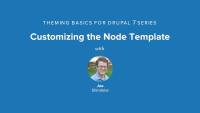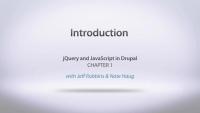Walks through the process of copying the default node.tpl.php file from the core node module into the theme, and then customizing the output specific to individual in order to match the design. See how to add specific variables, when to use conditional if statements and the best way to debug and iterate through this process.
Additional resources
In this chapter, we add some sidebar and footer regions to the page via the .info files, and printing those new regions out in our page template file, adding some blocks to help with testing. We also talk about Devel and Krumo, and how we can use those to find out everything that is available in out page array, using the dsm() function. While inspecting out page array, we point out the differences between elements and properties within renderable arrays.
Additional resources
This video walks through the process of replacing static content in the page.tpl.php file with dynamic variables. Joe talks about the html.tpl.php file as well as pointing some of the important variables that should be included within the theme.
Additional resources
This video goes through some of the strategies for translating a design into a Drupal theme. We talk about the two approaches of adding the HTML to an existing Drupal theme template vs. inserting dynamic variables into the HTML provided by our designer. Throughout this video, we're going to be assuming that our designer has delivered the full HTML, CSS and JavaScript to us, and we'll be adding in the dynamic variables. In this process we start to look at the design and start to break it up into it's component Drupal parts and start to strategize for how to build out the site and implement the design..
Additional resources
In this lesson we cover downloading and installing the WYSIWYG module. We show the relationship between the WYSIWYG editor and Drupal Text Formats. We go over the basic settings of the WYSIWYG module, how to download and install an editor, and configurations necessary in Text Formats to make things work properly.
Use this handbook page on Drupal.org to determine which version of TinyMCE is supported with CKEditor: Editors.
Additional resources
Goes through the process of creating a view of something other than content. In this case it's a view of users, and this chapter talks about other types of views of entities that are possible from different base tables.
This video series will continue the Job Board example from the Fields for Site Builders series where we will discover ways to display all of the job postings, allow people to find the one they are looking for and easily apply for it.
Here we'll see how to customize what our View is showing by using the views formats. We look at a few different format styles and discuss the difference between using the fields or content settings for display.
This video series will continue the Job Board example from the Fields for Site Builders series where we will discover ways to display all of the job postings, allow people to find the one they are looking for and easily apply for it.
Standardized documentation is crucial to a project, whether it is just you or an entire team working on it. In this tutorial we're going to look at:
- Standards for
@docblockcomments - Standards for inline comments
- Why standards for documentation and comments are as important as standards for the rest of your code.
By the end of this tutorial you'll know how to add inline documentation for all the PHP code that you write for Drupal.
Learn how to integrate jQuery scripts into Drupal, and how to leverage the JavaScript capabilities of the Drupal API in both 6.x & 7.x
Jeff Robbins and Nate Haug introduce the jQuery and Drupal integrations that we'll be building in this series, based on the foundations of theming, module development, and jQuery.
- How to add jQuery to a theme
- How to utilize Drupal's drag and drop behavior to reorder elements on a page within any form that has orderable items
- Drupal's direct integration with jQuery through the Forms API in Drupal 6 and Drupal 7
- Building a highly optimized AJAX request to Drupal that will return a JSON result
- The JavaScript state system in Drupal 7
Note: The examples in the video span across Drupal 6 and Drupal 7, and jQuery code that will work either in jQuery version 1.2.6 or 1.4.







